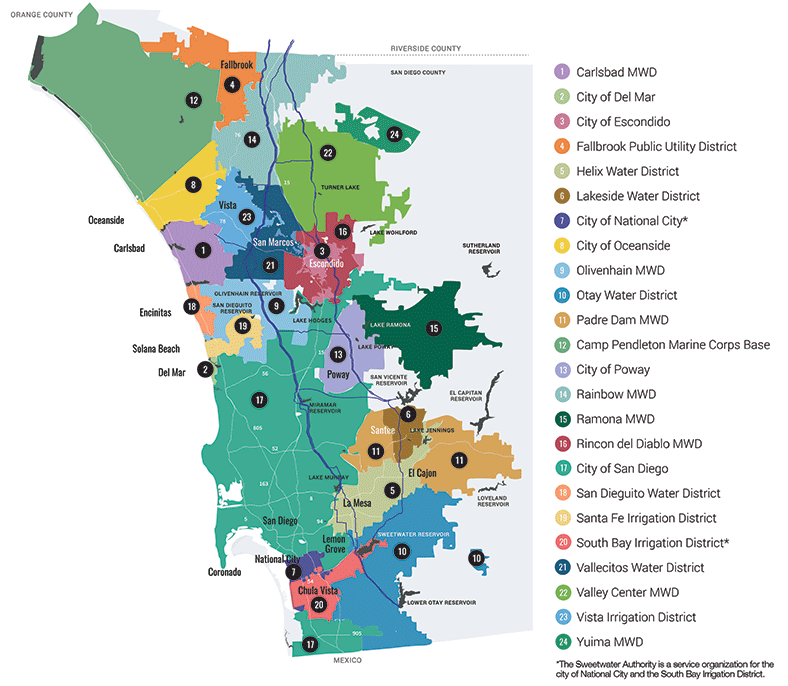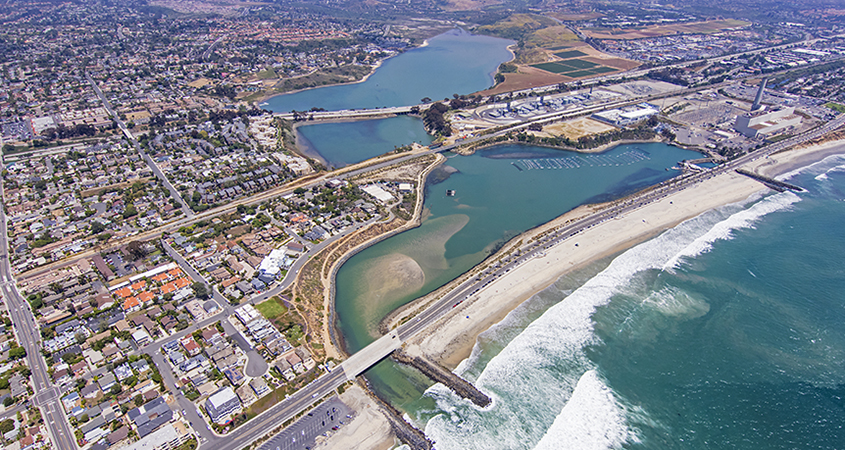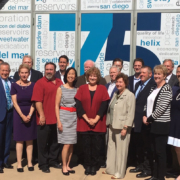The San Diego County Water Authority’s Board of Directors celebrated the agency’s 75th anniversary during today’s Board meeting, which included 20 proclamations honoring the agency for its service to the region dating back to 1944.
Cities across the region joined the state Assembly and Senate, the San Diego County Board of Supervisors and other state and local leaders to formally mark the occasion. The San Diego City Council and the San Diego County Board of Supervisors even proclaimed today “San Diego County Water Authority Day” in honor of the agency’s legacy of water supply reliability.
75 years of service
“Starting with the historic first water deliveries in the 1940s, the Water Authority has partnered with our member agencies to build, operate and maintain the vital infrastructure that supports our region’s $231 billion economy and unparalleled quality of life,” said Board Chair Jim Madaffer. “Our collective investments have created extraordinary advances in water supply reliability that are sustained by the daily vigilance necessary to operate and maintain such a complex system.
“While today we celebrate the past, the Water Authority and its 24 member agencies continue to focus on the future by fostering innovative solutions to ever-changing water resource challenges,” Madaffer said. “Together, we will supply the San Diego region with safe and reliable water supplies for generations to come.”

Since 1991, the Water Authority and its 24 member agencies have deployed one of the most aggressive water supply diversification strategies in the nation to improve regional water supply reliability. In the years ahead, member agency projects will play an increasingly important role in continuing to ensure reliability for the San Diego region.
Forward thinking on water
The Water Authority’s current forward-thinking efforts include developing water storage capacity in Lake Mead to provide additional drought resilience for San Diego and the Southwest.
The agency also is working closely with the City of San Diego to assess a potential pumped storage project at San Vicente Reservoir that could help meet clean energy goals and benefit water ratepayers. In addition, the Water Authority is analyzing the costs and benefits of a regional water conveyance system that could help San Diego County and the entire Southwest to more effectively manage water resources.
Profound impact
During today’s ceremonies, water agency, civic and business leaders noted the Water Authority’s profound impact on the San Diego region and wider water issues over the past 75 years.
- “A reliable water supply is critical for San Diego’s regional economy and for maintaining a competitive business climate. The business community applauds the Water Authority and its 24 member agencies for their leadership, and for increasing the county’s water supply reliability with investments that keep our economy growing.” — Mark Cafferty, president and CEO, San Diego Regional Economic Development Corp.
- “It is a pleasure to celebrate the San Diego County Water Authority’s 75th anniversary. We share a common history and a common vision for water supply reliability that has been essential to the economic vitality and prosperity to all San Diegans. We look forward to strengthening our relationship to meet the future needs of San Diegans.” — Gloria D. Gray, chair, Metropolitan Water District Board of Directors
- “Farming is a foundational piece of our regional economy and quality of life – but it doesn’t happen without a reliable water supply. Our farmers are constantly innovating to use water more efficiently by adopting new technology and planting more-efficient crops.” — Eric Larson, executive director, San Diego County Farm Bureau
- “On behalf of the Imperial Irrigation District Board of Directors, I salute the San Diego County Water Authority on its 75th anniversary. Our two agencies are partners in the nation’s largest agriculture to urban transfer and in the process, we have forged a durable alliance at the Salton Sea. It is a relationship that the IID highly values.” — Erik Ortega, president, Imperial County Irrigation District Board of Directors
- “By combining a diversified set of water supply sources with greatly enhanced storage capacity, we are developing a more robust safety net for San Diego County.” — Jerry Sanders, president and CEO, San Diego Regional Chamber of Commerce
On June 9, 1944, San Diego voters approved the Water Authority’s formation under the County Water Authority Act. Imported water arrived three years later to slake the thirst of a growing population just weeks before local supplies would have run out.
The modern era of the Water Authority started during deep, drought-induced water supply cuts in the early 1990s. Since then, Water Authority and its 24 member agencies have deployed one of the most aggressive water supply diversification strategies in the nation to improve regional water supply reliability.
At the same time, the agencies have aggressively helped to reduce per capita water use so that the total regional water use today is well below 1990 levels despite significant growth in the population and economy.

Officials commemorate installation of the first portion of pipe along the new Second Pipeline of the San Vicente Aqueduct in 1951. Photo: Water Authority
75th anniversary milestones
The Water Authority reached several major milestones over the past two decades. They include:
- In 2003, Olivenhain Dam was the first major new dam built in San Diego in more than 50 years. At 318 feet, it was the tallest roller-compacted concrete dam at the time.
- In 2008, the Twin Oaks Valley Water Treatment Plant north of San Marcos began operations. It was the largest submerged membrane water treatment plant in the world when it was commissioned.
- In 2011, the San Vicente Tunnel and Pipeline Project – an 11-mile long, 12-foot diameter tunnel with an 8-1/2-foot diameter pipeline – created a link from the City of San Diego’s San Vicente Reservoir to the Water Authority’s Second Aqueduct, greatly improving the Water Authority’s ability to distribute water and store water in the reservoir.
San Vicente Dam raise
- In 2012, the Lake Hodges Hydropower Facility started serving the dual purposes of connecting the lake to the Water Authority’s aqueduct system and generating 40 megawatts of clean, on-demand electricity.
- In 2014, the San Vicente Dam Raise Project, the tallest dam-raise project in U.S. history, expanded the reservoir’s capacity by more than 157,000 acre-feet.
- In 2015, the $1 billion Claude “Bud” Lewis Carlsbad Desalination Plant, distribution pipeline and related facilities started commercial operations as the largest seawater desalination project in North America.
- The Water Authority’s Asset Management Program, which includes a multi-year project to reline 82 miles of large-diameter prestressed concrete cylinder pipelines with new steel liners, helps to prevent pipeline failure and extend their lifespans by 75 years or more at significantly less cost than traditional pipeline replacement programs.

San Diego regional water quality regulators issued a new permit in May 2019 for the development of permanent, stand-alone seawater intake and discharge facilities at the Carlsbad Desalination Plant. Photo: Water Authority
Worldwide recognition
The Water Authority’s innovative efforts have been recognized nationally and internationally.
In 2017, for instance, the president of the American Society of Civil Engineers recognized the Water Authority’s Emergency & Carryover Storage Project for winning ASCE’s top international engineering award.
The same year, Water Authority was honored by the Association of California Water Agencies – the nation’s largest statewide coalition of water agencies – for innovation and excellence in water resources management with its addition of supplies from the Carlsbad Desalination Project. And in 2016, the Water Authority received a top national award from the Association of Metropolitan Water Agencies for its commitment to improving the region’s water supply reliability in a manner that balances economic, social and environmental needs.






